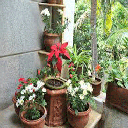Uttarakhand is a state located in the northern part of India. It is often referred to as the Land of Gods due to the many holy Hindu temples and cities found throughout the state, some of which are among Hinduism's most spiritual and auspicious places of pilgrimage and worship. Known for its natural beauty and wealth of the Himalayas, the Bhabhar and the Terai, the state was carved out of the Himalayan and adjoining north-western districts of Uttar Pradesh .Apart from the Tarai region in the Shivalik foothills, the entire state of Uttaranchal is a part of the Himalayan ranges. At 7,817 m above sea level, Nanda Devi in the district of Chamoli is the highest point in the state. The region has many glaciers, passes, meadows, and trekking routes with several major rivers like the Ganga and Yamuna originating from here. A major part of this Himalayan state comes under rainforests and alpine forests that are home to some of the highly endangered wildlife species,on 9 November 2000, becoming the 27th state of the Republic of India.It borders the Tibet Autonomous Region on the north, Nepal on the east and the Indian states of Uttar Pradesh to the south, Haryana to the west and Himachal Pradesh to the north west. The state has two distinct climatic regions: the predominant hilly terrain and the small plain region. The climatic condition of the plains is very similar to its counterpart in the Gangetic plain-that is, tropical. Summers are unbearable with temperature going over the 40°C mark and a lot of humidity. Winters can be chilly with temperatures going below 5°C at times. The peace and tranquility of Uttaranchal laid the foundation for a treasure house of paintings and art. Out of the two major art forms, the art of stone carving and woodcarving are fairly well known. The art of stone carving gradually died down, but woodcarving continued. Woodcarving could be seen on almost every door of a Garhwali house until only half a century ago. Woodcarving can still be seen in hundreds of temple all over Garhwal. The remains of architectural work have been found at the Chandpur Fort, temple of Srinagar, Pandukeshwar (near Badrinath), Devi Madin (near Joshimath), and Devalgarh Temple. The state of Uttaranchal has tremendous potential of developing tourism industry due to the beautiful landscape, religious places, trekking trails, national parks, mountain peaks and historical and archeological sites. Apart from tourism, the rural population is engaged in agriculture. Doon Valley, Nainital district, Udham Singh Nagar and Haridwar districts produce large quantities of food grains. The state has immense potential for the development of horticulture crops-apple, orange, malta,pear, grapes peach, plum appricot, litchi,mango, guava etc are widely produced fruits. The region also holds good promises for developing herbal pharmaceutical industry owing to abundant medicinal plants. The industrial sector of state is insignificant. It is hoped that by development and proper exploitation of its natural resources, Uttaranchal can overcome its economic backwardness. The alpine and tropical rainforests that cover most parts of the state make natural habitats of some of the best-known wildlife creatures India has on offer. The Jim Corbett National Park is home to Royal Bengal Tigers and ground for the plot of Jim Corbett's Man-eaters of Kumaon. Another rainforest in the region is Rajaji National Park famous for its large number of pachyderms. Alpine forests in the region include Valley of Flowers National Park (known for its amazing variety of flowers), Nanda Devi National Park, Govind National Park, Gangotri National Park, and many more.
Jwala Devi Temple:On the top of Benog hills close to Benog Wildlife Sanctuary 9 km to the west of Mussoorie and at an altitude of 2104 mtrs. is the Jwala Devi Temple. The hill top temple is known to bless and grant wishes of the devotees who come to seek the true blessings and has an idol of Mata Durga in it. Jwala Devi temple is situated within the verdant lush forest that also offers classic views of entire Mussoorie, Doon Valley, River Yamuna, Yamuna Bridge and other things. The temple is surrounded by thick forests and offers a panoramic view of the Himalayan peaks, Doon valley and Yamuna valley. Surkanda Devi Temple:Reaching for the gods at 3,030 meters the temple of Surkanda is the highest point around Mussoorie. Besides place of mind it offers a glorious view. To get this temple one has to drive 31 km up to Kaddukhal (2,559m) from Mussoorie and then walk up 1.5 km to the hill top which offers a spectacular view of 320 km of snow capped Himalayas. The temple itself is mythological site. Legend says that the head of the charred body of Goddess Sati fell here, when Lord Shiva was taking her remains along with him after she give her life in the yajna started by her father. Sir George Everest House:At a distance of 6 km is The Park Estate of Sir George Everest, First Surveyor General of India. Who had his office and residence here, is approachable by road. The highest peak in the world, Mount Everest is named after him. Lakha Mandal:Past Kempty Falls, Lakha- Mandal is 75 km on Mussoorie- Yamunotri Road. One can drive up to KUWA about 71 km and from there river Yamuna is to be crossed by a motorable bridge. There are hundreds of idols of archaeological importance which have been preserved by the Archaeological Survey of India. Legend has it that the Kauravas made a shellac house and conspired to burn the Pandavas alive here. Clouds End:The bungalow built in 1838 by a British Major was one of the first four buildings of Mussoorie. The bungalow has since then been converted into a hotel called Clouds End, and is situated at the extreme west of Mussoorie Hill, 8 km from library. The resort is surrounded by thick forest, offers a wide variety of flora & fauna besides a panoramic view of snow clad Himalayas & Yamuna River. The most ideally suited resort for foreigners and honeymoon couples. Nag Devta Temple:An ancient temple situated on Cart Mackenjie Road and is about 6 km from Mussoorie. Vehicles can go right up to the spot. It provides a charming view of Doon Valley as well as of Mussoorie. Landour:A small cantonment town contiguous with Mussoorie is about 35 km from the city of Dehradun, Uttarakhand. Landour is located in the Lower Western Himalayas and it is 1,500 ft above Mussoorie. The twin towns of Mussoorie and Landour, together are a well-known British Raj-era hill station in northern India. Landour is a pollution-free zone, and with fresh pure air to breathe, recovery from any stress or disease is superbly fast here. During old times, the Britishers set up a rejuvenation centre to enjoy the nature at its best. During the Raj, it was common to give nostalgic English, Scottish, Welsh or Irish names to one's home, reflecting one's ethnicity. Landour Bazaar is located on a steep slope about 4 km up the hill from the Mall. Landour bazaar is 150 years old and sprang up to serve the needs of British soldiers who were sent to the Landour convalescent depot to recover. Today, it continues to be loyal to its locals rather than pandering to the needs of tourists as much of the other markets do. Silversmiths and Shoemakers ply their wares alongside second-hand clothes vendors. Visit the bazaar to pick up necessities as well as some unexpected items. After shopping, stop for some breakfast and cold coffee at Char Dukaan, said to be frequently visited by Ruskin Bond. They also sell his books here. Landour is also home to the acclaimed Woodstock School, a residential school spread over 250 acres of forest region. Lakshman Jhula:Uttaranchal the state of India is a home attractions of all type like ancient Temples, Spiritual Places, historical monuments, world class architectures, beaches and so many others tourist places in North India. Rishikesh Attraction are just waiting for you to come and see the sights all of them on your trip to Rishikesh in the Uttaranchal. If you separate these tourist attractions by the region, you will find thousand of attraction in this region which includes Lakshman Jhula of Rishikesh. It is main attraction of Rishikesh. Lakshman Jhula was built in 1939. In Vedic era Lakshman crossed Ganga on jute ropes between the places where this bridge is built. It is a major attraction among the tourists to Rishikesh. It is situated in Rishikesh Uttaranchal. The Ganges crosses this bridge. Mythology have it that Lakshman, brother of lord Rama once crossed Ganges on a suspension bridge made of jute. The new bridge is said to be built on the same place of the famous bridge. Badrinath temple: is one of the main tourist attractions in Uttaranchal. The temple is surrounded by two ranges named 'Nar' and 'Narayan'. The holy temple is surrounded by the mountain ranges and the nearest peak is the called 'Neelkantha' peak. This temple is regarded as 'the abode of Lord Vishnu'. The name Badrinath is derived from the local word 'badri' which means berries. The temple is positioned at a height of 3,133 meters and the route is pretty difficult but it is the faith that makes the pilgrims travel across these hilly roads and reach the temple. The temple stands on the banks of river Alakananda. The thermal spring near the temple is one of the main attractions and it is here that the tourists freshen up, before going for the puja. Baij Nath Temple:Himalayas play a great part not only in Hindu mythology, but also in the Hindu Religion. Visiting Baij Nath Temple, Kausani located amidst the mountain ranges with the splendid sceneries around, can be an enchanting experience. Known to be specked with auspicious pilgrimage destinations in Uttaranchal all over, the place is rightly named as the abode of Gods. These Temples in Uttaranchal play an important part in Uttaranchal Tourism. 53 kms north of Almora, Kausani is a magnificent hill station replete with picturesque and splendid views. The 300 km wide view of the Himalayas is spectacular. Kausani is nestled amongst deep pine forests, on a hill top where the view of the snow capped Trishul and Nanda Devi is so clear that one feels the snow is at a touching distance. Gangotri Temple:Known for pilgrimage, Uttaranchal is rightly named as the abode of Gods. Hindu temples can be found at almost every fold as you take to the mountains of Uttaranchal. Himalaya offers you excellent scenic beauty. Visiting Gangotri Temple can be an enchanting experience amidst the mountain ranges and the splendid sceneries around.One of the four sites of pilgrimage of India, Gangotri is the seat of river Ganga. It is the point from which it originates and plummets down the hills, valleys and plains stretching approximately 2500 kms across the Indian subcontinent. Among the Greater Himalayas, Gangotri at an altitude of 3048 mts holds immense mystic charm. The town Gangotri by the banks of River Bhagirathi is a quaint town with remains gripped with an aura of the pristine atmosphere. Ram Jhula: the other suspended Iron Bridge was recently builds between Shivanand Ashram and Swarg Ashram. This Jhula is similar to the Lakshman Jhula. It is also called Shivanand Jhula of Rishikesh. Lal Tibba: This place is top point in Mussoorie. Lal Tibba is situated in Landhour area which is the oldest inhabited place in Mussoorie. Landhour still carries method of British era. It was here that Britishers first settled. The buildings, the structural design everything tells a saga of an English past. After India gained freedom many Britishers settled here.Even the name, Landhour was given by Britishers. In 1967, the municipal corporation of Mussoorie ordered a Japanese Telescope which is placed on Lal Tibba.Thorough this telescope one can have a beautiful sight of many peaks in Himalayan range like Badrinath, Kedarnath, Banderpunch etc. Lal Tibba is considered as most good-looking place in Mussoorie. Har Ki Pauri Temple:Hindu temples can be found at almost every fold as you take to the mountains of Uttaranchal. The Himalayas offer you excellent scenic beauty. Often most sought after retreat for sages keen to seek the path of God, Himalaya became a home to many. On their spiritual quest, there arose many temples connected to Indian mythology which later became great sites for pilgrimage. Visiting Har Ki Pauri Temple can be an enchanting experience amidst the mountain ranges and the splendid sceneries around. Known for pilgrimage, Uttaranchal is rightly named as the abode of Gods. Har Ki Pauri Temple in Haridwar was built by King Vikramaditya who had in memory of his brother Bhatrihari's long spiritual quest on the banks of the river Ganga had constructed it. The temple was also known as called Brahamakund. Auspicious for the Hindus, devotees take a holy dip before offering prayers. Footprints of Lord Hari are found in the temple. Kedarnath Temple:Kedarnath Temple is one of the eminent pilgrimage destinations of India. The holy shrine, situated on the Himalayas, is the place where thousands of pilgrims renew their faith every year. Kedarnath Temple is located at a height of 3583 m and even though the route to Kedarnath Temple is very tough indeed, the religious faith is what keeps the pilgrims going, overcoming all hindrances and obstacles, to reach their desired destination. The hilly path and the deep gorges make the journey full of thrill and adventure. The temple is the house for the Shiva 'lingam' and devotees visit the place to receive blessing from Lord Shiva. This temple carries a legendary story. The Pandavas, after the battle of Kurushetra wanted to meet lord Shiva, but their patience was examined by the lord. The Pandavas where asked to visit Kedar to meet lord Shiva. Devotees visit the place as it is believed lord Shiva is one of the creators of the earth. The Shiva lingam is the mainly worshipped here for the well-being of mankind. Madmaheshwar Temple:Truly an Abode of God, Uttaranchal boasts its mythological association. From time immemorial, the unvoiced sentinels known as Himalayas guarded this place from many an unfriendly confrontations endowing it with peace and serenity. This peaceful land is a resort of Gods, so called Devbhoomi by people of India. Studded with some of the most renowned pilgrim spots, Uttaranchal is a Tourists paradise. The ringing of temple bells striking the ears, the aromatic smell of incense sticks and the non stop chanting of Mantras creates a powerful impact on the onlooker. It helps him to reawaken his soul, long being in stupor due to the pollution of advancing civilization. Natural calamities and foreign invasions have contributed in the slow destruction of temples, but by conjoint effort of the inhabitants and Government these temples were slowly recovered and reconstructed. One such is the Madmaheshwar Temple. Rudranath Temple:Passing through the glorious mountain ranges of Himalaya tourist will reach the land of Hindu god and goddess. Rudranath temple in Gaurikund is situated amidst the thick woods of Uttaranchal. The mountain formation in the area is strange and if looked at closely, resembles the face of Lord Shiva, and is thus known as 'Rudramukh'. The word 'Mukh' means face, and the word 'Rudra' refers to Lord Shiva. This place is situated at a height of 2,286meters and is surrounded by pristine nature and mountainous flora. In this place Lord Shiva is worshipped as 'Neelkantha'. The idyllic ambience and the unspoilt nature make the place more pious and sacred for the devotees. Not only the domestic tourists, but the international tourists too, will always find nirvana in the Himalayan ranges. The land and the spirituality associated with it make a perfect combination for the people who want to enjoy their holidays in Uttaranchal. Naina Devi Temple:Nainital is a beautiful hill-station in the state of Uttaranchal, surrounded by mountains on the three sides. Earlier, this area of Nainital had many lakes and it was known as the 'City of 60 Lakes' or 'Chakta'. Most of the lakes have disappeared in the present times. Now, the very life of the town of Nainital revolves around the lake of Naini. There are few other lakes in and around Nainital which are equally attractive and beautiful as the Naini Lake. The hill-station of Nainital was discovered by a British called Lord Barron in the year 1841. It is known that the mesmerizing beauty of the surroundings and the pleasant weather of the place impressed the British administrator very much. Lord Barron transformed the hill-station of Nainital into the summer capital of the United Province. The splendid hill-station of Nainital is a major tourist attraction and is always bustling with visitors. Bagnath Temple:The Himalayas offer you excellent scenic beauty. Often most sought after retreat for sages, keen to seek the path of God, Himalaya became a home to many. Visiting Bagnath Temple, Bageshwar can be an enchanting experience amidst the mountain ranges and the splendid sceneries around. Known for pilgrimage, Uttaranchal is rightly named as the abode of Gods. Hindu temples can be found at almost every fold as you take to the mountains of Uttaranchal. Bageshwar is a small town with many religious legends. It is famous for an ancient Shiva temple. Bagheswar is situated at the meeting point of Gomti and Surya Rivers. Situated about 90 kms from Almora, Bageshwar is an important tourist spot. Famous for its Bagnath Temple, devotees flock here during the month of Shravan to worship the Lord who is remover of sorrows. Chandi Devi Temple:On a Neel Parvat in Haridwar, Chandi Devi temple is located where pilgrims either climb for about 45 mins up the steep hill to reach the temple premises. It is one of the well known pilgrimages where devotees flock to seek the blessings of the Goddesses who is believed to fulfill the wishes. The image of the Goddess in the Chandi Devi Temple is said to be installed by Adi Shankaracharya in 8th century A.D. Chandi Devi temple is one of the most ancient temples of north India. According to Hindu mythology the ancient kingdom of Lord Indra was captured by two demons called Shumbh and Nishumbh who had thrown the Gods from the heaven.Prayers of the gods were heard Chandika Devi, a powerful Goddess was formed from the cells of Goddess Parvathi. She was a beautiful and dynamic Goddess and demon King Shumbh wished to marry her. Gaurikund Temple:Traveling to the Northern part of India can be a very exhilarating experience. If you are an avid trekker and hiker you will enjoy the mountains, the beauty of the snow capped hills as well as the trail that leads to the Greater Himalayan peaks and the beautiful temples in Uttaranchal that lie nestled in its folds. In the yester years sages seeking God ventured to the Himalayas. Himalayas play a great part in Hindu mythology. It is often considered the abode of Gods. If you are planning a tour in Uttaranchal, visiting Gaurikund Temple can be an enchanting experience amidst the mountain ranges and the splendid sceneries around. Known for the various religious Places in Uttaranchal, the state is rightly named as the Devbhoomi. Tourist attractions in Uttaranchal are in no dearth. Gaurikund is at an altitude of 1982 mts. above sea level. Hemkund Saheb:Known for pilgrimage, Uttaranchal is rightly named as the abode of Gods. Hindu temples can be found at almost every fold as you take to the mountains of Uttaranchal.Himalaya offers you excellent scenic beauty. Visiting Hemkund Saheb, Joshimath can be an enchanting experience amidst the mountain ranges and the splendid sceneries around. Hemkund Saheb located about 4329 mts. above sea level is famous pilgrimage for both Sikhs and Hindus. Known to be an auspicious place where the 10th Sikh Guru, Guru Govind meditated by the Hemkund Lake to attain enlightenment, the Sikh Gurudwara was built on its banks. Mansa Devi Temple:The town of Haridwar is located in the foothills of the Himalayas in the north Indian state of Uttaranchal. Haridwar represents the point where the Ganga reaches the plains. Haridwar is an ageless attraction as the perfect pilgrimage destination, which has been held in reverence for centuries. The town of Haridwar is crowded with several temples and ashrams. A visit to Haridwar is really like stepping into a completely different world. The towns of Haridwar and Rishikesh were previously known as Gangadwara and it reperesents the gateway to the Himalayan pilgrimage shrines of Badrinath and Kedarnath. The town of Haridwar has a very rich and ancient cultural and religious heritage. In the ancient scriptures of India, this region of Haridwar is popularly known by the name of Mayapur. Neelkanth Mahadev Temple:Located at an altitude of 1675 m on the hilltop of Swarg Ashram, is the shrine of Neelkanth Mahadev. The Neelkanth Mahadev temple is considered to be one of the most famous temples of Rishikesh. With temples at almost every fold of the Himalayan Range, Hindu mythology is closely associated with most of these temples. The temple of Neelkanth Mahadev is associated with Lord Shiva, and he is the presiding deity. According to Hindu mythology it was the place where Shiva drank up the venom churned out of the ocean, to save the world from the evil, death and destruction. It is said that Lord Shiva had the immense capacity to stop the venom from entering his body and thus reserved it in his throat forever. The poison did not harm him but turned his throat murky blue. Yamunotri Temple:Known for pilgrimage, Uttaranchal is rightly named as the abode of Gods. Hindu temples can be found at almost every fold as you take to the mountains of Uttaranchal. Himalaya offers you excellent scenic beauty. Visiting Yamunotri Temple can be an enchanting experience amidst the mountain ranges and the splendid sceneries around. Located in Uttaranchal Yamunotri temple can be reached from Rishikesh, Dehradun or Haridwar. One of the four pilgrimage sites or Char Dham Yatra of India, Yamunotri dedicated to Goddess Yamuna is a shrine situated in the Garhwal Himalayas. Perched on the Bandar Poonch peak which is about 3.165 mts above sea level, the path way to the Yamunotri temple is very picturesque. Situated opposite to Gangotri, Yamunotri is the source of the river Yamuna which originates from the Champasar Glacier which is about 4,321 mts above sea level.


































































